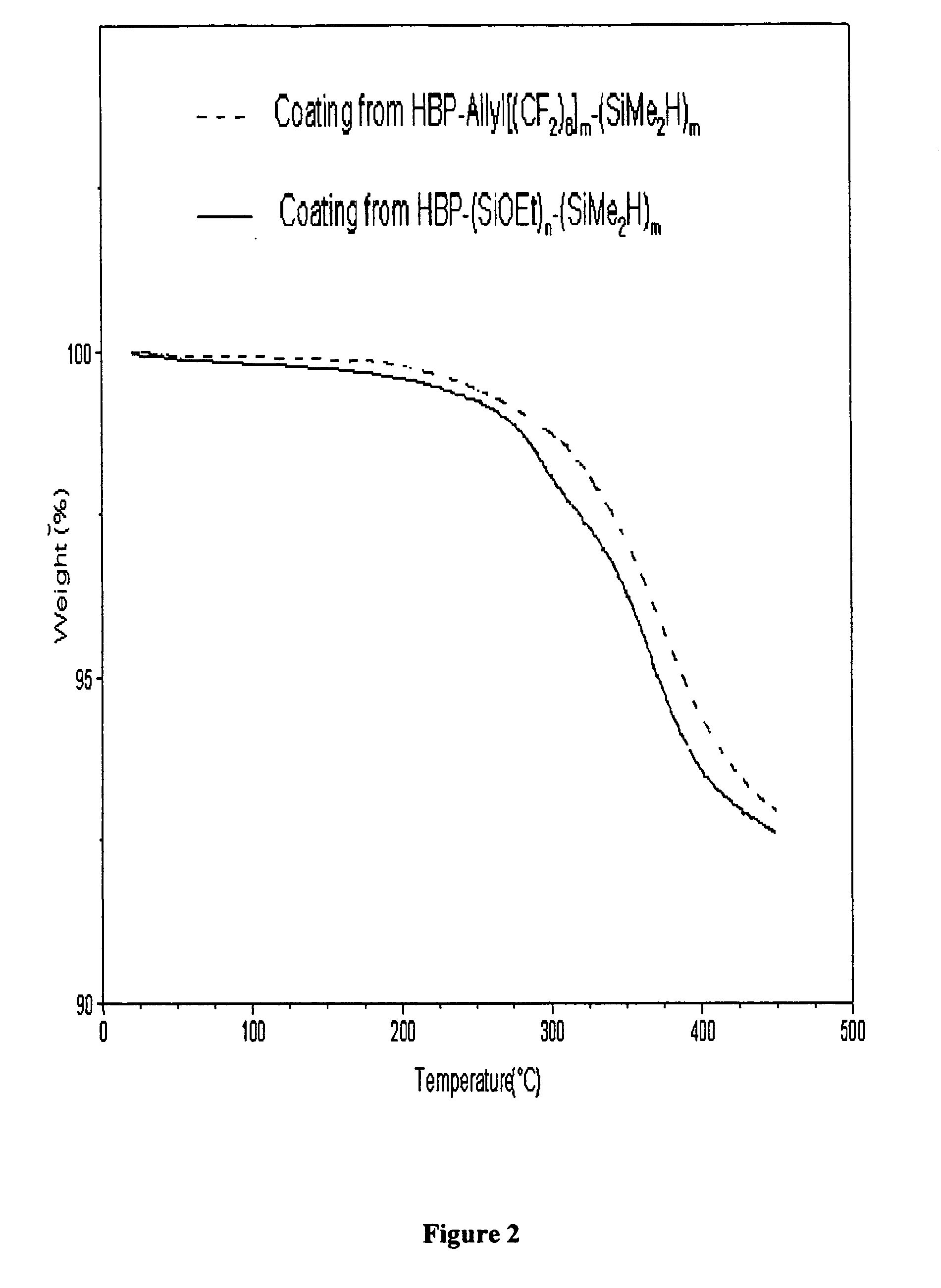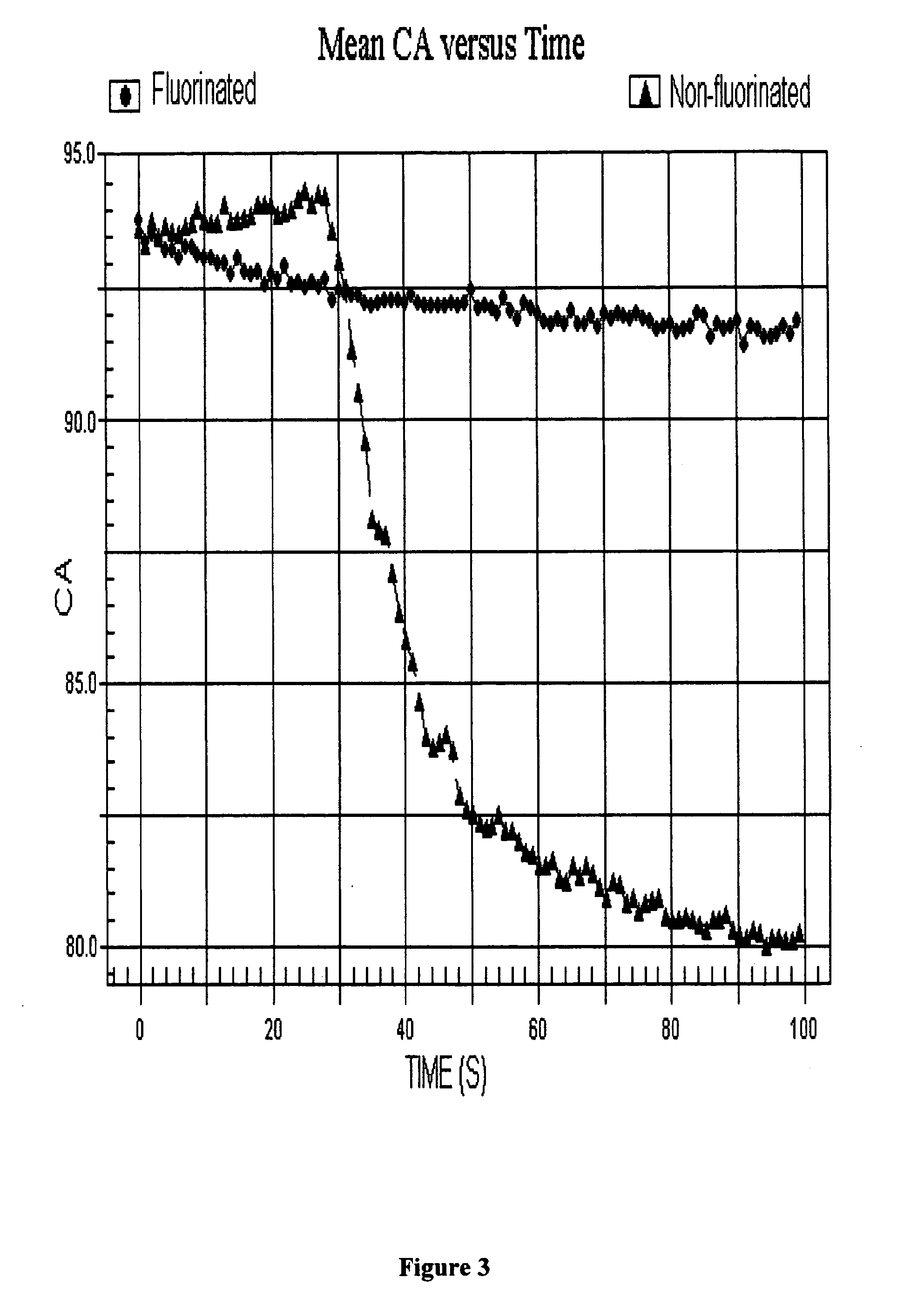Networks containing perfluorocarbon organosilicon hyperbranched polymers
a perfluorocarbon organosilicon and polymer network technology, applied in the field of perfluorocarbon organosilicon polymer network containing hyperbranched domains, can solve the problems of limited application of ptfe in some applications, limited application as a solution-born coating material, and inability to use it in liquid-based applications such as lubricating fluids or base oils, and achieves high hydrophobicity, high oleophobicity, and high thermal stability
- Summary
- Abstract
- Description
- Claims
- Application Information
AI Technical Summary
Benefits of technology
Problems solved by technology
Method used
Image
Examples
example 1
Synthesis of hyperbranched (perfluorocarbon / siloxane) polymers HBP-[(CF2)n]—(SiMe2H)(n=4) using 1,4-divinyloctafluorobutane (A2) and tetrakis(dimethylsiloxy)silane (B4) with [B4] / [A2] ratio of 1.3
[0056]A 50 mL round-bottom flask equipped with a vertical cooling condenser was charged with 1,4-divinyloctafluorobutane (2.52 g, 85.5%, 8.50 mmol), tetrakis (dimethylsiloxy)silane (3.77 g, 97%, 11.13 mmol) and 10 mL of anhydrous THF. It was flushed and then stirred under N2 for 5 min. To the reaction mixture was added 12.5 mg of the Karstedt's catalyst (˜2% platinum-divinyltetramethyldisiloxane complex in xylene) which was then stirred at RT for 1 hr, followed by heating in an oil bath at 50° C. for 2 days and to 65° C. for another 16 hrs. The volatiles were then stripped off in a rotary evaporator. The product was washed with anhydrous acetonitrile (3×10 mL). Each time, the solution was pre-cooled with a dry ice bath before the acetonitrile was decanted from the product phase. The volatil...
example 2
Synthesis of hyperbranched (perfluorocarbon / siloxane) polymers HBP-[(CF2)n]—(SiMe2H) (n=6) using 1,6-divinylperfluorohexane (A2) and tetrakis(dimethylsiloxy)silane (B4) with [B4] / [A2] ratio of 1.3
[0065]A 25 mL round-bottom flask equipped with a vertical cooling condenser was charged with 1,6-divinylperfluorohexane (0.594 g, 97%, 1.63 mmol), tetrakis (dimethylsiloxy)silane (0.730 g, 97.1%, 2.16 mmol) and 2 mL of THF. It was flushed and then stirred under N2 for 5 min. To the reaction mixture was added 11.5 mg of the Karstedt's catalyst (˜2% platinum-divinyltetramethyl-disiloxane complex in xylene). It was stirred at RT for 1 hr, and then at 65° C. for 2 days. The volatiles were stripped off in a rotary evaporator. The product was washed with anhydrous acetonitrile (3×5 mL). Each time the solution was pre-cooled with a dry ice bath before the acetonitrile was decanted from the product phase. The volatiles were stripped off in a rotary evaporator at RT, and the resulting colorless visc...
example 3
Synthesis of hyperbranched (perfluorocarbon / siloxane) polymers HBP-[(CF2)n]—(SiMe2H) (n=8) using 1,8-divinylhexadecafluorooctane (A2) and tetrakis(dimethylsiloxy)silane (B4) with [B4] / [A2] ratio of 1.5
[0074]A 25 mL round-bottom flask equipped with a vertical cooling condenser was charged with 1,8-divinylhexadecafluorooctane (1.0029 g, 98%, 2.17 mmol), tetrakis (dimethylsiloxy)silane (1.1616 g, 97.1%, 3.43 mmol) and 5 mL of THF. It was flushed and then stirred under N2 for 5 min. To the reaction mixture was added 14 mg of the Karstedt's catalyst (˜2% platinum-divinyltetramethyl-disiloxane complex in xylene). It was stirred at RT for 1 hr, and then at 80° C. for 2 days. The THF solvent was removed with a rotary evaporator at RT. The product was washed with anhydrous acetonitrile (3×5 mL). Each time, the solution was pre-cooled with a dry ice bath before the acetonitrile was decanted from the product phase. The volatiles were stripped off in a rotary evaporator at RT, and the colorless...
PUM
 Login to View More
Login to View More Abstract
Description
Claims
Application Information
 Login to View More
Login to View More - R&D
- Intellectual Property
- Life Sciences
- Materials
- Tech Scout
- Unparalleled Data Quality
- Higher Quality Content
- 60% Fewer Hallucinations
Browse by: Latest US Patents, China's latest patents, Technical Efficacy Thesaurus, Application Domain, Technology Topic, Popular Technical Reports.
© 2025 PatSnap. All rights reserved.Legal|Privacy policy|Modern Slavery Act Transparency Statement|Sitemap|About US| Contact US: help@patsnap.com



